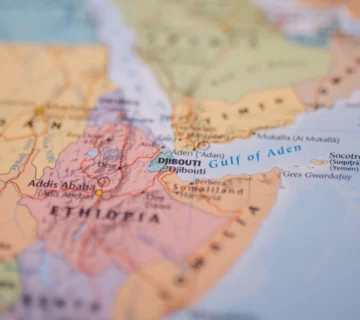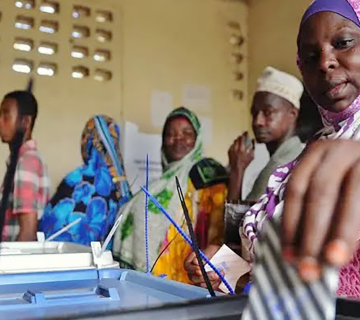Kenya’s global ranking in corruption has been poor for several decades now and the fight against corruption has remained legendary political rhetoric. Intermittently, some actions have been taken to demonstrate the government’s commitment to the fight against corruption. However, such actions are a mere smokescreen overlying intricate realities that normalize the vice. No serious convictions and recoveries of assets have been made in grand corruption scandals, and corruption is far from diminished. Corruption is a leading factor that undermines economic development in Kenya and might undermine the country’s Vision 2030.
The recent scandal at National Youth Service (NYS), in which allegedly Ksh. nine billion was lost, has been characterized by dramatic arrests and arraignment of 23 suspects of the listed 54, amid tough talk by Kenya’s president. A spate of alleged corruption scandals has hit the country, from NYS (Ksh. nine billion), National Produce and Cereals Board (Ksh. 1.9 billion), Kenya Pipeline (Ksh. 70 billion), National Irrigation Board (multibillion scandal), Kenya Electricity Transmission Company (Ksh. 6.3 billion) to Kenya Power among others. An executive directive to vet heads of procurement and accounting officers in the public service was also issued by the president. These, while positive, are usual reactionary measures that have characterized the war against graft in Kenya, especially around explosive scandals such as the foregoing.
The fight against corruption has come a long way, since the Prevention of Corruption Act of 1956. The Act’s amendment in 1997 established the Kenya Anti-Corruption Authority (KACA). KACA came in the period of gross systematic institutionalization of corruption by former President Daniel Moi’s regime and the then political class, which had led to the suspension of aid to Kenya by the International Monetary Fund. KACA was seen as a step towards institutionalization of the fight against corruption. The agency was, however, disbanded and the chairman (Harun Mwau) hounded out of office a few years later. It was replaced by Anti-Corruption Police Unit (ACPU) in 1999 which was disbanded shortly after. In 2003, the Kenya Anti-Corruption Commission (KACC) was created by dint of Anti-Corruption and Economic Crimes Act of 2003 and the Public Officer Ethics Act of 2003, with Justice Aaron Ringera as its Chair. His pressured resignation saw the disbandment of the agency in 2009.
The Ethics and Anti-Corruption Commission (EACC) was then created in 2011 through the Ethics and Anti-Corruption Commission Act of 2011. Other consequential enactments include Proceeds of Crime and Anti-Money Laundering Act of 2009, which established Assets Recovery Agency, Financial Reporting Centre among other anti-corruption structures. Anti-Corruption Court and Economic Crimes Division have recently been created in the judiciary. In the same spirit, an elaborate anti-corruption infrastructure has been established comprising of a Multiagency Team (MAT) made up of the National Intelligence Service (NIS), Directorate of Criminal Investigations (DCI), Office of Director of Public Prosecution (ODPP), National Police Service (NPS), Financial Reporting Centre (FRC), Ethics and Anti-Corruption Commission (EACC), Kenya Revenue Authority (KRA), Kenya Wildlife Service (KWS), and the Immigration Department.
With the elaborate anti-graft infrastructure, serious milestones should have been achieved by now and corruption could be in its death bed. Sadly, the converse is true and the attendant ridiculing of mega corruption scandals in the court of public opinion reveals the level of desensitization and cultural encoding of corruption among Kenyans. The smokescreen that is ‘war against corruption’ in Kenya can, thus, be laid bare.
Lack of political will is probably the single most important factor undermining the fight against corruption. This is demonstrated by parliament’s legendary role in undermining the tenure of anti-corruption chiefs and disbandment of anti-corruption agencies: Harun Mwau (KACA), Justice Aaron Ringera (KACC), Patrick Lumumba (EACC), Mumo Matemu (EACC), and Phillip Kinisu (EACC). The Auditor General, Edward Ouko, who has been undoubtedly the vanguard of the war against corruption survived impeachment by parliament in 2017. On the other hand, parliament has also curiously shot down corruption-related impeachments such as that of Health Cabinet Secretary, Sicily Kariuki in March this year, after the alleged intervention of the Deputy President (William Ruto). More interestingly, in 2015, President Uhuru Kenyatta and his deputy, William Ruto, initially came to the defence of the then Cabinet Secretary for Devolution and Planning, Anne Waiguru, following the loss of over Ksh 790 million at the National Youth Service. The leader of the majority in National Assembly, Aden Duale and his Senate counterpart, Kithure Kindiki, in a joint press conference and through a joint article on the Standard Digital on July 18, 2015, defended Waiguru, terming corruption allegations against her as ‘smear politics.’ Other ranking ruling (Jubilee) party politicians also came to her defence. Legal prosecution of the matter is still grinding on (to a possible futile halt). Parliament has also failed to explicitly criminalize corruption by not passing tougher regulations, laws, and penal codes. Parliament has also failed in the vetting of public officers appointed to high levels of public service, especially those with questionable integrity issues. Parliament has been seen as the executive’s rubberstamp in most of these appointments.
Conflict of interest also rests at the heart of the fight against corruption. Various anti-corruption agencies and officials have suffered this scourge, which ultimately impairs their effectiveness and objectivity. The Goldenberg Commission of Inquiry that was constituted to look into the Goldenberg scandal involving possible theft of over Ksh. 150 billion lost revealed that, the director of the Special Branch (current National Intelligence Service), James Kanyotu, was the main business partner of Kamlesh Pattni (main architect) at Goldenberg International Limited, the company at the centre of the scandal. Former president, Daniel Moi was a shareholder by nominee at the company. Philip Murgor (the then director of public prosecutions) had his firm represent the Central Bank of Kenya (whose top officials were allegedly complicit) during the inquiry. No meaningful prosecutions nor recoveries were made on this scandal. Most recently, Phillip Kinisu, former chairperson of Ethics and Anti-Corruption Commission was forced to resign following dealings between his firm, Esaki Limited, and National Youth Service in 2015 in yet another corruption scandal that involved the organization.
The ODPP and the judiciary have also been perceived to be stumbling blocks in the fight against corruption in Kenya. The ODPP has in the past failed to conduct thorough investigations to present solid cases against graft suspects. This has led to the dismissal of cases on grounds of inadequate evidence or staying long in the corridors of justice. This has therefore seen no meaningful sentencing of graft perpetrators in all mega corruption scandals in the country. The judiciary has also been accused of dragging judgments through postponements, tolerance to aggressive litigations or issuance of blocking orders to stop investigations and prosecutions. In 2014, the High Court issued orders barring probe into graft allegations against Machakos governor, Alfred Mutua and reinstated impeached Embu governor, Martin Wambora. In 2007 for instance, the then KACC chairperson Justice Aaron Ringera lamented High Court’s order barring investigations between KACC and Serious Fraud Office (SFO) of the United Kingdom (UK) into the Anglo-leasing scandal. The Anglo-leasing scandal cases have been derailed for long in the judicial quarters beyond the eath of some of the accused persons such as Wilfred Koinange, David Mwiraria (former finance minister), and Chris Murungaru (former security minister).
The rank and file members of the judiciary have also been found guilty of corruption and this defeats loyalty to the cause. The 2003 Ringera Judiciary Report for instance found 5 of 9 Court of Appeal Justices, 18 of 36 High Court Judges and 82 of 254 Magistrates, guilty of corruption. In 2014, the Registrar of the Judiciary, Boss Shollei was fired over a Ksh 2 billion scandal. In 2016, former Chief Justice Willy Mutunga and Majority Leader in the National Assembly, Aden Duale, engaged in a war of words on Twitter painting each other’s institutions as more corrupt, at the height of investigations over bribery allegations against Supreme Court Judge, Philip Tunoi. This proves a major case of institutional rot that creates a permissive environment for corruption and a hostile milieu for the rule of law.
There is also sa elective application of justice that massages impunity and undermines the rule of law in the fight against graft. This is experienced in high profile cases. The High Court in 2006, blocked the prosecution of former vice president, George Saitoti, following his implication in the Goldenberg scandal. Moody Awori, a former vice president, was also implicated in the Anglo-leasing scandal but was never prosecuted. Former President, Daniel Moi, was also not prosecuted nor investigated further even after recommendation by the Goldenberg Commission of Inquiry.
Dishonesty among relevant agencies is also undermining the fight against corruption in Kenya. The DCI and EACC in 2014 cleared the Chickengate scandal suspects of any wrong doing. Co-suspects, Smith and Ouzman executives in the United Kingdom, were however found guilty and convicted in 2015 by SFO. In the Counties for instance, County Assemblies which are mandated to play oan versight role, had turned into lynch mobs that threatened governors and county executives with impeachments in retaliation to failed demands. The 2014/2015 Controller of Budget’s report revealed that the County legislators have also been unjustifiably spending billions in foreign trips unchecked.
To make the fight against corruption real and potent, a strong criminalization (in law with consistent penal code – perhaps capital punishment) of corruption should be done through legislation. Chapter Six of the new constitution needs to be observed in public service and public appointments to ensure recruitment of public officers with high integrity. Oversight, investigative, prosecutorial, and judicial agencies need to secure their independence from political manipulation, they need to unearth previous mega corruption scandals and to facilitate recovery of public assets. If possible, they need to develop inter-operable guidelines (among other institutional reforms and capacity building measures) for efficiency and effectiveness. The rule of law should always be upheld and applied equally, and this means even the mighty have to be held accountable, prosecuted and sentenced in corruption cases. The fight against corruption also needs to be earnestly charged from the top-most level of political leadership and public administration, and by so doing offered unlimited political will. Equal focus should also be directed to county governments and all public institutions.



